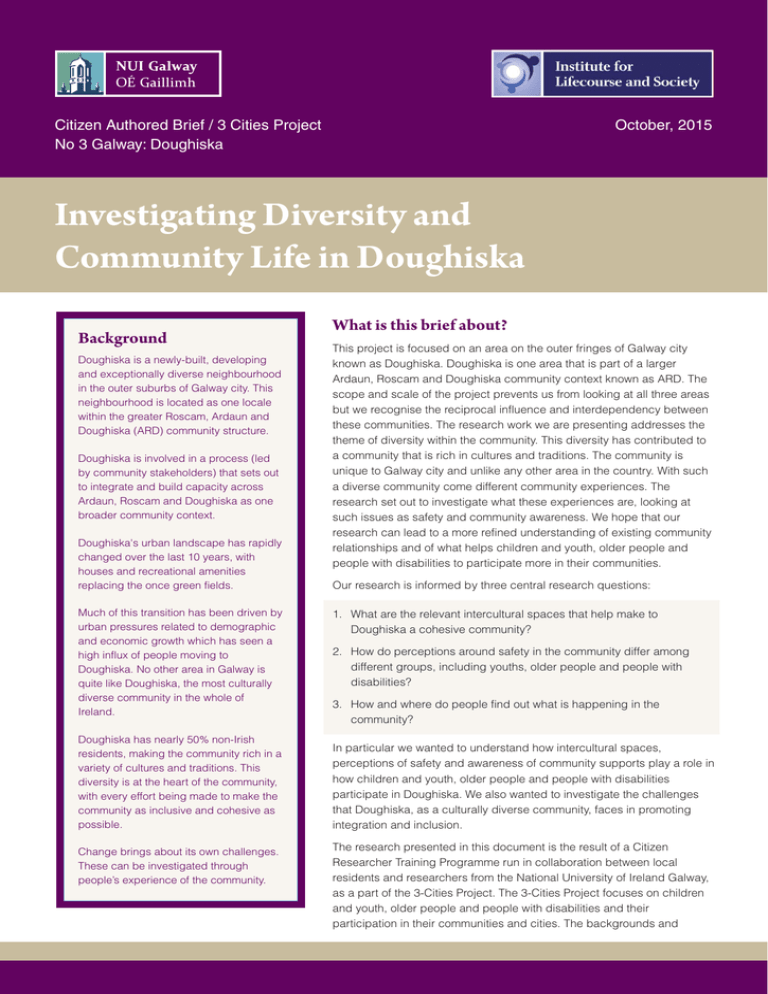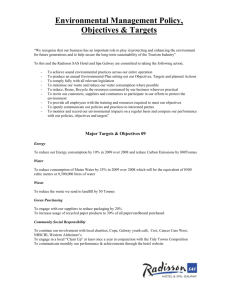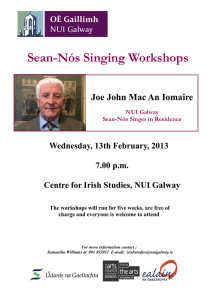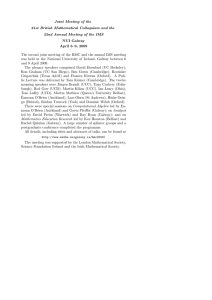Investigating Diversity and Community Life in Doughiska What is this brief about? Background
advertisement

Citizen Authored Brief / 3 Cities Project No 3 Galway: Doughiska October, 2015 Investigating Diversity and Community Life in Doughiska Background Doughiska is a newly-built, developing and exceptionally diverse neighbourhood in the outer suburbs of Galway city. This neighbourhood is located as one locale within the greater Roscam, Ardaun and Doughiska (ARD) community structure. Doughiska is involved in a process (led by community stakeholders) that sets out to integrate and build capacity across Ardaun, Roscam and Doughiska as one broader community context. Doughiska's urban landscape has rapidly changed over the last 10 years, with houses and recreational amenities replacing the once green fields. Much of this transition has been driven by urban pressures related to demographic and economic growth which has seen a high influx of people moving to Doughiska. No other area in Galway is quite like Doughiska, the most culturally diverse community in the whole of Ireland. Doughiska has nearly 50% non-Irish residents, making the community rich in a variety of cultures and traditions. This diversity is at the heart of the community, with every effort being made to make the community as inclusive and cohesive as possible. Change brings about its own challenges. These can be investigated through people’s experience of the community. What is this brief about? This project is focused on an area on the outer fringes of Galway city known as Doughiska. Doughiska is one area that is part of a larger Ardaun, Roscam and Doughiska community context known as ARD. The scope and scale of the project prevents us from looking at all three areas but we recognise the reciprocal influence and interdependency between these communities. The research work we are presenting addresses the theme of diversity within the community. This diversity has contributed to a community that is rich in cultures and traditions. The community is unique to Galway city and unlike any other area in the country. With such a diverse community come different community experiences. The research set out to investigate what these experiences are, looking at such issues as safety and community awareness. We hope that our research can lead to a more refined understanding of existing community relationships and of what helps children and youth, older people and people with disabilities to participate more in their communities. Our research is informed by three central research questions: 1. What are the relevant intercultural spaces that help make to Doughiska a cohesive community? 2. How do perceptions around safety in the community differ among different groups, including youths, older people and people with disabilities? 3. How and where do people find out what is happening in the community? In particular we wanted to understand how intercultural spaces, perceptions of safety and awareness of community supports play a role in how children and youth, older people and people with disabilities participate in Doughiska. We also wanted to investigate the challenges that Doughiska, as a culturally diverse community, faces in promoting integration and inclusion. The research presented in this document is the result of a Citizen Researcher Training Programme run in collaboration between local residents and researchers from the National University of Ireland Galway, as a part of the 3-Cities Project. The 3-Cities Project focuses on children and youth, older people and people with disabilities and their participation in their communities and cities. The backgrounds and Investigating Diversity and Community Life in Doughiska individual profiles of the citizen researchers are diverse, as are their motivations for participating in the research process. For residents there was a combination of factors that motivated involvement in the training. This included appreciation for the area, the desire to share knowledge of Doughiska with a wider public, contributing to the community, querying fixed ideas of community life in Doughiska, acquiring research skills and interest in being involved in a collaborative research project. In addition to contributing to the overall participatory methodology of the project, there are also a number of important reasons for why the 3-Cities Project team wanted to work with citizen researchers. These included: providing local children and youth, older people and people with disabilities with a way to contribute to the research directly; the aspiration to promote engagement with community issues at grassroots level; to help make sure the 3-Cities Project is relevant to the lives of children and youth, older people and people with disabilities; and to harness the insights of local residents on what it is like to live in their community. What we did The research presented in this brief was developed by eight citizen researchers from Doughiska in collaboration with two researchers from the 3-Cities Project. The Citizen Researcher Training Programme encompassed three workshops which covered the main stages of research, from developing a research question, to designing a research study, to collecting data and, finally, to interpreting and reporting what was found. Key issues around how to conduct research in an ethical manner were also covered in these workshops. Citizen-Led Research The citizen-led research presented here is part of other research activities conducted by the 3-Cities Project team in Doughiska. The 3-Cities Project research involved a Collaborative Forum with key community stakeholders and with local children and youth, older people and people with disabilities. The Collaborative Forum identified important topics around community participation that needed to be researched. In Doughiska these topics included: In addition to helping to guide other research activities completed as part of the 3-Cities Project in Doughiska, citizen researchers identified key research questions based on these topics that they wanted to research. Two primary research questions were identified by the citizen researchers, which led to three distinct projects being completed. The 3-Cities project aims to engage in a collaborative process to re-imagine services and communities to maximise participation for children and youth, older people, and people with disabilities in their localities and cities. The project focuses on Galway, Limerick and Dublin. Project 1: Identifying intercultural spaces that help to make Doughiska a cohesive community The aim of this project emerged principally from a desire to identify significant spaces where people from different cultures and backgrounds came together in Doughiska. We felt the need to investigate what makes these spaces appeal to such a diverse community. In particular, we wanted to explore how these spaces can encourage community integration and promote positive relations between residents of Doughiska. We took photos (referred to as photo elicitation in research) in order to capture the information we needed. We then selected some photos to discuss with the other citizen researchers. This helped us to gain a deeper understanding of what these spaces meant for them. 1. Identifying intercultural spaces that help to play a role in developing a cohesive community. Project 2: Exploring how perceptions 2. Exploring how perceptions around safety in the community can differ among groups, including youths, older people and people with disabilities. around safety in the community can differ among groups, including youths, older people and people with disabilities 3. Investigating how and where do people find out what going on in the community? In this project we used both photography and a focus group to capture and investigate key 1 The 3-Cities Project includes dedicated focus groups with service providers and residents in the area representing the relevant groups of children and youth, older people and people with disabilities. Other methods entailed discussion of themes in a collaborative forum and in-depth data collection using Experiential and Lifecourse interview methodologies. experiences, observations and opinions around safety in the community. In order to capture people’s perceptions of safety, we took photos of places we felt some people may not feel safe in. The focus group further explored the perceptions around safety in the community and this method added to the discussion around the photos. Project 3: How and where do people find out what’s happening in the community? The third project involved researching how awareness of supports and community events is spread around the community. With the community being so diverse, the research team wanted to explore how people from different cultures and backgrounds were made aware of the supports available to them and to find out if residents of Doughiska know what is happening within the community. Having such a diverse community can pose challenges relating to the spreading of information. The team decided that a focus group may help them investigate this further. What we found out “People put their differences aside and unite through mass” (Participant 5 - photo elicitation discussion) 2. The Playground The playground in Doughiska is known all over Galway city for its abundance of swings and slides. Figure 2. The playground, Doughiska Project 1: The spaces that we photographed highlighted that there are only a few places within Doughiska where people from different backgrounds and cultures gathered together. These areas were: 1. Cumasu Centre and Good Shepherd Parish 2. The playground 3. The green pitches We chose these areas to represent intercultural spaces as we felt in these areas people left their differences aside and united through religion, sport and a desire for a better unified community. It appears out of the landscape in a gentle manner that is inviting for everyone. It is a haven for young children to come and play. The playground was chosen as an intercultural space as it facilitates young children from different cultures and nationalities to get to know each other through play. It is a hub of activity during the day and acts as a focal point within the community. 3. The Green Area 1. The Cumasu Centre Figure 1. The Cumasu Centre and Good Shepherd Parish, Doughiska Road. The Cumasu Centre and Good Shepherd Parish were highlighted as key spaces that encourage integration and inclusion for all in the Doughiska community. We felt the parish made great efforts, through religion, to bring people from different cultures together. It was expressed that it does not matter who you are or what you believe in everyone is made to feel welcome. Figure 3. The green pitches in Doughiska We felt that the green area signified an open place that was available for anyone to come and enjoy. It does not belong to one group but to the community as a whole. The green area is at the heart of Doughiska and we felt it to be one of the most used amenities in the area. Investigating Diversity and Community Life in Doughiska The photos selected led to discussions around why these spaces promoted integration and feelings of a more cohesive community. We felt, along with others from the citizen research training, that when they went to these places people felt comfortable and free to express themselves without judgement and to enjoy their surroundings. The three spaces highlighted also signified the importance of having spaces for people to integrate into a community in ways other than through formal services. “Everyone uses the green; it’s a space that’s at the heart of Doughiska” (Participant 3 - photo elicitation discussion) Having spaces that encourage residents to go outside and enjoy their community enables people to get to know each other. The focus group, which involved a women’s group from Doughiska, suggested that the woods is the biggest asset of the Doughiska community. Its abundance of wildlife and pathways allows people to feel like they are nestled away in the countryside. People felt that the woods were a space that offered peace and tranquillity for all residents to enjoy. “We are privileged to have such an amazing place on our doorstep” (Focus group participant 1) We debated that the three spaces encouraged participation by youths, older people and, to an extent, people with disabilities. But concern was raised over the fact that these spaces may not be accessible for some people with specific disabilities. Even so, in our exploration of intercultural spaces we have found that these areas are an important component of community life in Doughiska. What we found out Project 2: In this project, we wanted to capture and explore key experiences, observations and opinions around community safety. Doughiska is a new, diverse and developing community. Nearly half of all residents are non-Irish with over 43 different nationalities making Doughiska their home. We felt that many of these people may not know one another. This could be due to high levels of rented accommodation and the community being so new. The lack of familiarity with neighbours and the community as a whole, we felt, could lead to feelings of being unsafe. We wanted to explore if this was the case and if different perceptions of safety exist between different groups within the community. The methods used to explore this were both photo elicitation and a focus group held with a local women’s group. Merlin Woods and the unfinished estates were highlighted as possible places where people may not feel safe: 1. Merlin Woods Figure 4. Merlin Woods, Doughiska We wanted to explore what people’s feelings were about Merlin Woods. In order to investigate people’s perceptions of safety and the woods we decided to have a group discussion around the photos taken by the research team and to hold a focus group with local residents. Figure 5: Merlin Woods walkway, Doughiska We reflected as a group on what the visual data in the form of photos signify to us. This discussion involving the other research training participants outlined how the woods acted as a divide between other neighbourhoods and Doughiska. This was both positive and negative. Some people were happy to have a divide between certain areas. Others felt that the woods attracted youths from other areas near Doughiska to hang out in gangs. Some felt unsafe when walking through the woods when gangs of teenagers were present. Others viewed that some areas of the woods were safe. Several people regarded the woods as being a no-go area at certain times of day. The observations we collected from younger people during the discussion indicated that, by and large, their perception of safety and the woods was a negative one. The following quote captures some of the issues discussed at the focus group. “I enjoy walking through the woods during the day but at night like most places I would not feel safe” (Focus group participant 3) 2. Unfinished estates Figure 6. The unfinished estate, Doughiska The built environment in Doughiska, as a safety issue, was something we wanted to investigate. We wanted to explore how people felt about the ghost estates and unfinished paths that are present in Doughiska. Both the photo elicitation and focus group discussions highlighted how people felt the lack of paths and street lighting prevented them from feeling safe within the community. They outlined how some areas of the community were more affected. They expressed sympathy for families living on or beside unfinished estates. Overall, the findings from the project on safety depicted that the community felt safe. However, there were grey areas, such as the built environment, that people felt needed to be safer and to be better lit. The woods were regarded as a great asset to the community, but needed a stronger Garda presence for people to feel safer when walking alone through the woods. The resource centre was highlighted as a key player in bringing together people from all groups in the community. The focus group participants discussed how it provides training and support to individuals and groups of residents in the community, including a women’s group and computer classes. People said that the centre’s open-door policy made them feel more welcome. The strong efforts made by the ARD resource centre to connect community groups were echoed throughout the focus group. An upcoming ‘Pride of Place’ celebration, it was suggested, made people proud to be part of such a diverse community. The diversity of cultures and traditions we felt was viewed as a positive asset that the community can utilise and build on. What we found out Project 3: Information is so valuable and it could make the difference in people feeling included in the community or being isolated. With this is mind, we set out to investigate how people find out what’s happening in the community. The focus group provided us with some insights into how people in the Doughiska community found out what was going on. It highlighted the importance of having a community centre so that people can feel comfortable in dropping in and asking for information and advice. By and large, our exploration into awareness in the community led us to the ARD resource centre, pictured opposite. Figure 7. The ARD resource centre We discovered that, although the centre had been open for years, many people have only heard about it in recent times. We felt this could be due to its location and size. The centre is a small facility that can only cater for certain numbers. We felt that the rapid growth within the Doughiska community meant that some people may be unaware it exists. With that said, it was concluded that the work carried out by the ARD resource centre was a main contributor to having a sense of community within Doughiska. Investigating Diversity and Community Life in Doughiska Conclusion and Recommendations Our investigations into community life in Doughiska have generated some interesting conclusions. Although Doughiska is a relatively new community, it is interesting to see that strong efforts are being made to make the area more cohesive. It is significant that community connections are being made in spaces that are considered intercultural and that people feel comfortable expressing themselves in these areas. The research conducted would suggest that, as the community is so diverse, it can be difficult to include everyone. Despite the efforts being made through services and community events, some individuals and groups may not want to participate. We felt that this wish needs to be respected. Doughiska has taken strides to make the community as inclusive as possible for children and youth, older people and people with disabilities. This was evident in discussions with different residents about the Pride of Place celebration. As a developing community, it was highlighted that more work from local authorities and government bodies, including the Gardaí, is required in order to invest in the future of the rapidly growing population of young people. While feelings around safety within the community varied amongst different groups, the research did suggest that having a stronger Garda presence in the area, along with improved street lighting, would enhance safety. We hope that by raising awareness of these issues our research will contribute towards making participation of different groups within the Doughiska community a reality. Research Team Hugh Murphy, Citizen Researcher, Doughiska, Galway Temi Oyelola Citizen Researcher, Doughiska, Galway Imelda Muroyi Citizen Researcher, Doughiska, Galway Chichi Oborunfemi Citizen Researcher, Doughiska, Galway Caelum Buckley, Citizen Researcher, Doughiska, Galway Shauna Diamond Research Assistant Project Lifecourse, NUI Galway Giselle Russen, Citizen Researcher, Doughiska, Galway Hannah Russen, Citizen Researcher, Doughiska, Galway Victoria Ugbade Citizen Researcher, Doughiska, Galway Dinali Wijeratne Research Assistant Project Lifecourse, NUI Galway Kieran Walsh 3 Cities Coordinator, Deputy Director with the Irish Centre or Social Gerontology, Project Lifecourse NUI Galway Project Lifecourse The 3-Cities Project marks the first major programme of work undertaken by Project Lifecourse. Project Lifecourse is funded by The Atlantic Philanthropies and represents Ireland’s most visible contribution to the growing international field of life course studies. By combining and harnessing existing strengths and international networks from across the UNESCO Child and Family Research Centre (CFRC), the Irish Centre for Social Gerontology (ICSG), and the Centre for Disability Law and Policy (CDLP). Institute for Lifecourse and Society NUI Galway, Galway, Ireland Telephone: +353(0)91492934 Website: www.nuigalway.ie/lifecourse/the_3_cities_project.html



